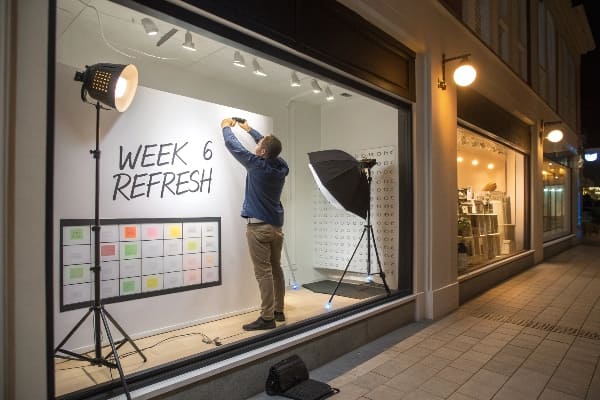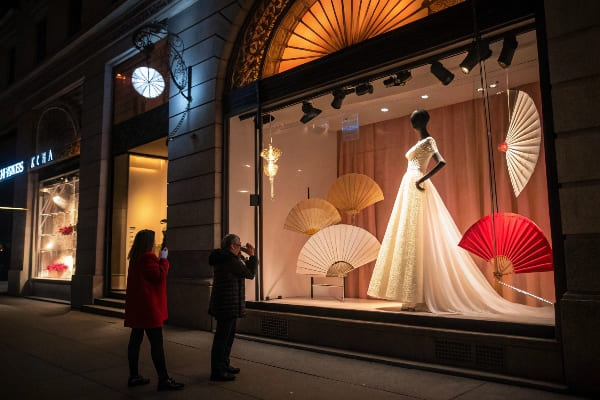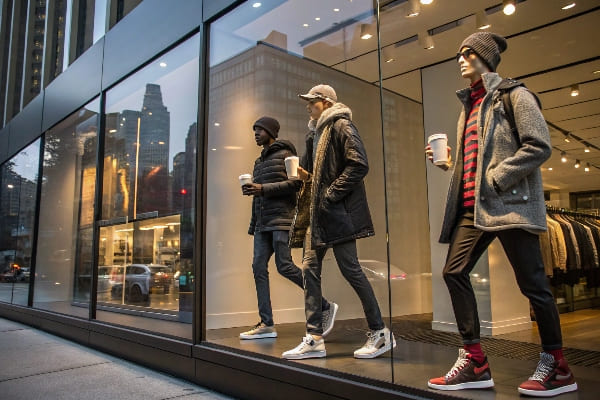The street never sleeps, and neither should your shopfront. Shoppers tune out stale scenes fast.
Change your window display every four to eight weeks to keep attention, match product cycles, and invite returning shoppers to stop and look again.

A fresh facade signals an active, caring brand. I have seen sales lift the very week we swap a tired scene for a bold new one.
What is the psychology of window displays?
A passer-by walks past dozens of stores every day. Their brain ignores most of them.
Window displays use color, motion, and storytelling to break automatic scanning and spark an emotional desire to enter.

How the mind reacts
The human eye looks for novelty. I place one strong focal point at eye level. That point triggers curiosity. Then contrast moves the gaze across the scene. Warm lighting creates comfort. Motion prompts a micro-pause that buys me two extra seconds of attention.
Table: Elements and Effects
| Element | Psychological Effect | Simple Tip |
|---|---|---|
| Color contrast1 | Heightens alertness | Use a bold accent against a muted field |
| Symmetry | Eases processing | Align props so the brain rests |
| Movement2 | Extends gaze time | Add a slow-turning platform |
| Story cues3 | Engages memory | Show a clear beginning, peak, end |
When I tested a hunting-themed scene for a U.S. client, adding a subtle moving spotlight on the cardboard crossbow stand raised store entry by 18 %. The mind followed the moving light, then the product story finished the hook. That single tweak proved that psychology drives foot traffic more than the product alone.
Why is it important to maintain displays?
Dust on glass whispers that the staff no longer care.
Regular upkeep protects brand trust, prevents safety hazards, and keeps the message sharp.

Keeping the promise alive
I set a weekly checklist. We wipe prints, tighten props, check lights, and swap any cardboard parts4 that sag. A display costs money; neglect wastes that money twice—first in lost impact, then in repair. Clean surfaces signal respect. For our wholesale buyers, I guarantee that every cardboard unit survives the season if maintained.
Table: Maintenance Tasks
| Task | Frequency | Impact if skipped |
|---|---|---|
| Glass cleaning | Weekly | Haze blocks color and light |
| Prop tightening | Weekly | Items fall, cause breakage |
| Light check | Bi-weekly | Dark spots hide products |
| Cardboard swap | Monthly | Bent edges look cheap |
Maintenance also feeds data. Each time we refresh, we note which items wear first. That guides our factory toward stronger folds or better coatings. Continuous small fixes stop big failures and protect the brand promise of “Outstanding Design Custom Personalized Cardboard Display Solutions Made Easy!”
Why window displays are important?
Without a window story, a shop is just a wall.
Displays translate brand values into a three-second street conversation that drives spontaneous entry and planned visits.

Bridge from street to sale
A window is the only medium that meets people in real life at life-size scale. Online ads show pixels; windows show presence. I treat the glass as a handshake. For our B2B clients5 in the U.S. and Canada, the window often doubles as proof of product scale. A well-lit crossbow on a sturdy cardboard riser tells hunters that performance matters. That silent statement seeds trust even before staff greet them.
Table: Business Goals Tied to Windows
| Goal | Display Role | Metric |
|---|---|---|
| Brand awareness | Visual identity recall | Social mentions |
| New product launch | First physical reveal | Launch week sell-through |
| Seasonal narrative | Connect to events | Foot traffic count |
| Competitive edge | Differentiation | Conversion rate |
A strong window also helps my repeat-order model. Retailers who see faster sell-through reorder more displays. That covers upfront design losses and keeps our factory lines humming.
What is the theory of window display?
Design looks like art, yet it follows rules like engineering.
Window display theory blends visual hierarchy, rhythm, balance, and storytelling to guide the viewer from first glance to store entry.

Core design principles
I learned early that random beauty fails commerce. Good theory starts with hierarchy6: one hero, few supporters, no clutter. Rhythm uses repeated shapes to move the eye. Balance prevents visual weight7 from tipping left or right. Finally, a mini-story8 gives context—problem, solution, reward. I sketch these layers before thinking about props.
Table: Principle Checklist
| Principle | Question to ask | Fast check |
|---|---|---|
| Hierarchy | Can I name the hero in one word? | Squint test; hero stays visible |
| Rhythm | Do shapes repeat at even pace? | Step back; follow the pattern |
| Balance | Is weight equal both sides? | Mirror halves in photo |
| Story | Does scene hint at outcome? | Ask a stranger what happens next |
Theory turns into profit when tested. One U.K. client selling sportswear doubled entries by centering a single neon shoe, repeating the neon line motif, balancing with two soft gray mannequins, and hinting at victory with a finish-line tape prop. The scene talked in seconds; shoppers walked in.
What’s most important when designing a window display for a retail clothing store?
Clothes hang on bodies, not boards.
Mannequin styling that mirrors the target customer’s lifestyle is the most critical element for clothing windows.

Dressing to connect
I choose mannequins that match the shopper’s age, build, and mood. Outfits must fit perfectly—no loose fabric, no pins showing. Lighting warms fabric tones. Cardboard risers hide underfoot clutter and lift accessories to hand height. For a beachwear brand, sand-colored pedestals and soft fans created motion in dresses. Shoppers felt the breeze, stepped inside, and bought the story.
Table: Clothing Window Priorities
| Priority | Why it matters | Quick tip |
|---|---|---|
| Mannequin fit | Shows real silhouette | Tailor garments, steam out creases |
| Color story | Guides mood | Limit to three hues |
| Lighting | Reveals texture | Use warm spots at 30° angle |
| Accessory placement | Completes look | Group in threes |
A retailer can survive a missing prop, but never a sloppy mannequin. When fabric pools at the ankles, it whispers discount bin. Tight styling shouts premium. That truth keeps my design team humble and disciplined.
How do I get into window display?
Many think you need an art degree. You need curiosity and patience first.
Start by studying store fronts, volunteer to style small boutiques, build a photo portfolio, and network with visual merchandisers.

Pathway from novice to pro
I began by sketching ideas for friends’ pop-up shops. I shot every window I loved, noted angles, props, shadows. Then I offered free weekend makeovers for local stores. Each makeover gave fresh photos. I posted them on LinkedIn, tagged shop owners, and wrote what I learned. Within six months a chain asked for a paid seasonal project.
Table: Entry Steps
| Step | Action | Result |
|---|---|---|
| Observe | Photograph windows daily | Train eye for detail |
| Experiment | Style a small space | Test ideas fast |
| Document | Build online portfolio9 | Show skills to clients |
| Network | Join VM groups | Find mentors |
| Educate | Take short courses10 | Learn technical skills |
Tools matter less than mindset. Carry a tape, cast-off cardboard, two LED strips, and fishing line. With those, you can prototype almost any scene. Persistence turns passion into profession. Brands value designers who solve problems11 on the fly, who know how to brace a cardboard crossbow stand so it holds real weight without sagging. That skill comes only from many late nights tweaking displays until they speak.
Conclusion
Change windows often, keep them clean, honor design theory, and tell clear stories; the street will reward your effort.
Understanding color contrast can enhance your design skills and improve audience engagement. Explore this resource for deeper insights. ↩
Discover how incorporating movement can significantly extend gaze time and improve viewer engagement. This link offers valuable strategies. ↩
Learn how to effectively use story cues to enhance memory retention in your presentations. This resource provides practical tips. ↩
Explore this resource to learn effective maintenance strategies that can prolong the life of your cardboard displays and enhance their visual appeal. ↩
Explore this resource to discover proven strategies that can enhance your B2B client relationships and boost sales. ↩
Exploring hierarchy in design helps you create clear focal points, enhancing user experience and engagement. ↩
Understanding visual weight is crucial for creating balanced designs that attract and retain customer attention. ↩
Learning to craft a mini-story in your designs can significantly improve storytelling and emotional connection with your audience. ↩
An effective online portfolio showcases your skills and attracts potential clients. Explore this resource to enhance your presentation. ↩
Short courses can provide essential skills and knowledge quickly. Discover options that can elevate your career in visual merchandising. ↩
Understanding how top designers tackle challenges can inspire your own creative solutions. Check out insights from industry leaders. ↩

